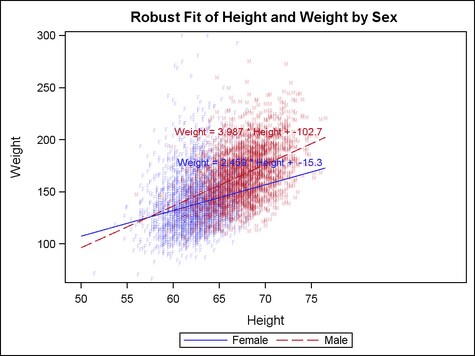Example Program and Statement Details
Example Program
The LINEPARM
statement draws a line based on a point and the slope of the line
that passes through that point. You can use this statement to create
a reference line with any slope or, in this example, to draw a fit
from a linear regression. Many SAS/STAT procedures create output data
sets containing a Y-intercept and slope and coefficient for the linear
regression equation.
proc template;
define statgraph lineparm;
begingraph;
entrytitle "Robust Fit of Height and Weight by Sex ";
layout overlay / xaxisopts=(offsetmax=.35);
scatterplot x=height y=weight / group=sex
markercharacter=eval(substr(sex,1,1))
markercharacterattrs=(size=5pt) datatransparency=.7;
lineparm x=0 y=intercept slope=slope /
name="Line" group=sex
curvelabel=eval("Weight = "||put(slope,5.3)||
" * Height + "||put(intercept,6.1))
curvelabellocation=inside
curvelabelattrs=(size=8pt);
discretelegend "Line";
endlayout;
endgraph;
end;
run;
proc sort data=sashelp.heart(keep=height weight sex)
out=heart;
by sex;
run;
ods exclude all;
proc robustreg data=heart method=m
outest=stats(rename=(height=slope));
by sex;
model weight=height;
run;
data all;
merge heart stats(keep=intercept slope sex);
run;
ods select all;
proc sgrender data=all template=lineparm;
run;
Statement Summary
The LINEPARM
statement creates a straight line. You can generate a single line
by specifying a constant for each required argument. You can generate
multiple lines by specifying a numeric column for any or all required
arguments. If any of the X= or Y= columns contains a missing value,
no line is drawn. To request a vertical line, specify
SLOPE= . (specify a missing value as a constant or column
value).
Required Arguments
specifies the X coordinate
of a point.
By default, if the
specified value is outside of the data range, then the data range
is extended to include the specified intercept. This behavior can
be changed with the CLIP= option. If a numeric-column is specified and the column contains missing values, no line is
drawn for the missing values.
specifies the Y coordinate
of a point.
By default, if the
specified value is outside of the data range, then the data range
is extended to include the specified intercept. This behavior can
be changed with the CLIP= option. If a numeric-column is specified and the column contains missing values, no line is
drawn for the missing values.
Options
specifies whether the
data for the line are considered when determining the data ranges
for the axes.
specifies a label for
the line.
The font and color
attributes for the label are specified by the CURVELABELATTRS= option.
specifies the color
and font attributes of the line label. See General Syntax for Attribute Options for the syntax
on using a style-element and Text Options for available text-options.
specifies the location
of the line label relative to the plot area.
Restriction: OUTSIDE cannot be used when the LINEPARM is used in multi-cell layouts
such as LATTICE, DATAPANEL, or DATALATTICE, where axes might be external
to the grid.
Interaction: This option is used in conjunction with the CURVELABELPOSITION= option to determine where the line
labels appear. For more information, see Location and Position of Curve Labels.
specifies the position
of the line label relative to the line end points.
Only used when CURVELABELLOCATION=OUTSIDE. The line label is positioned
automatically near the line boundary along unused axes whenever possible
(typically Y2 and X2) to avoid collision with tick values.
Interaction: This option is used in conjunction with the CURVELABELLOCATION=
option to determine where the line label appears. For more information,
see Location and Position of Curve Labels.
creates a separate
parameterized line plot for each unique group value of the specified
column.
Default: Each distinct group value might be represented in the graph by a
different combination of line color and line pattern. Line colors
vary according to the GraphData1:ContrastColor - GraphDataN:ContrastColor
style references, and line patterns vary according to the GraphData1:LineStyle
- GraphDataN:LineStyle style references.
Interaction: The group values are mapped in the order of the data, unless the INDEX= option is used to alter the default sequence
of line colors and line patterns.
The LINEATTRS= option can be used to override the
representations that are used to identify the groups. For example,
LINEATTRS=(PATTERN=SOLID) can be used to assign the same pattern to
all of the lines, letting the line color distinguish group values.
Likewise, LINEATTRS=(COLOR=BLACK) can be used to assign the same color
to all of the lines, letting the line pattern distinguish group values.
specifies indices for
mapping line attributes (color and pattern) to one of the GraphData1
- GranphDataN style elements.
Interaction: All of the indexes for a specific group value must be the same.
Otherwise, the results are unpredictable.
Interaction: The index values are 1-based indices. For the style elements in
GraphData1 - GraphDataN, if the index value is greater than N, then
a modulo operation remaps that index value to a number less than N
to determine which style element to use.
Discussion: Indexing can be used to collapse the number of groups that are represented
in a graph. For more information, see Remapping Groups for Grouped Data.
specifies the attributes
of the line. See General Syntax for Attribute Options for the syntax
on using a style-element and Line Options for available line-options.
specifies whether data
are mapped to the primary X (bottom) axis or to the secondary X2 (top)
axis.
Interaction: The overall plot specification and the layout type determine the
axis display. For more information, see How Axis Features are Determined.
specifies whether data
are mapped to the primary Y (left) axis or to the secondary Y2 (right)
axis.
Interaction: The overall plot specification and the layout type determine the
axis display. For more information, see How Axis Features are Determined.
